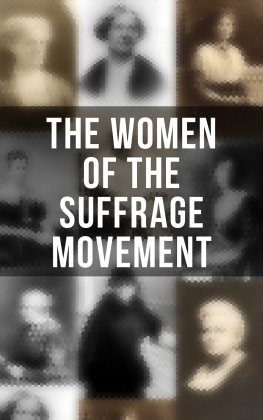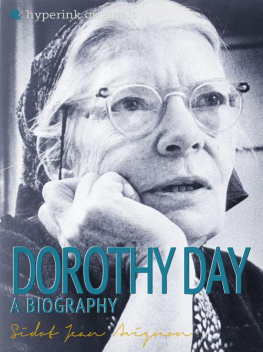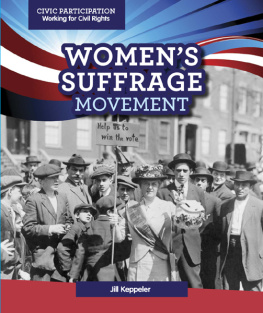FEMINISM
UNFINISHED
A SHORT, SURPRISING HISTORY OF
AMERICAN WOMENS MOVEMENTS
Dorothy Sue Cobble,
Linda Gordon, and Astrid Henry

LIVERIGHT PUBLISHING CORPORATION
A Division of W. W. Norton & Company
New York London
To the feminists of the future
CONTENTS
MORE THAN SEX EQUALITY:
FEMINISM AFTER SUFFRAGE
FROM A MINDSET TO A MOVEMENT:
FEMINISM SINCE
F eminism Unfinished provides the first history of the American womens movement over the approximately one hundred years since the womens suffrage amendment passed in 1920. Equally important, it challenges many popular understandings of the womens movement. Much of what is in this book will come as a surprise to many readers. But it is time to set the record straight.
This book is divided into three chapters and moves chronologically across a near-century of American womens activism. Since the intention of Feminism Unfinished is to be concise, none of the three chapters is comprehensive. To keep this book brief and as useful as possible, in each chapter we have chosen to focus on a few illustrative individuals, projects, and episodes in order to demonstrate the richness of the ferment and to illuminate major themes. Were the individuals we discuss all placed in a room together, they might well disagree, possibly sharply, but that is part of why feminism has flourished. We frequently use the plural word feminisms to emphasize that there have always been a variety of approaches to advancing womens well-being. This is true whether we are discussing the womens movements within a particular era or comparing feminisms across time.
All three chapters situate feminist movements in the larger politics, economics, and culture of the time: the Great Depression of the 1930s, Franklin Roosevelts New Deal presidency, World War II, 1960s prosperity, the Vietnam War, the rise of the Religious Right in the late 1970s, the introduction of the Internet, the 2008 economic crashall influenced the womens movement. All three chapters discuss continuities with earlier periods, but also the unfortunate ways that new generations have been ignorant, even disdainful, of earlier activism. Furthermore, much as we admire what feminist activists have done and are still doing, we are by no means uncritical of these movements. We believe we do feminist movements of the past greater honor by looking squarely at their limitations. We also believe that by thinking critically about the past, we can strengthen future feminisms.
T he history of feminism is important not just to feminists and not just to women. The womens movement we trace in this book has transformed the world we all live in, transformed it utterly. As individuals we have all changed, men as much as women. Institutions have changededucational, medical, religiousas have the professions, child-rearing practices, and the armed forces. Government has changed. So has the culture, from pop music, TV, and film to literature and the fine arts. The very nature of knowledge, whether in medicine, science, history, literature, or philosophy, has changed. One cannot understand the world we live in without an understanding of the womens movement and its influence. Feminism was integral to larger progressive changes, with the result that it has sometimes blended so entirely into larger movements that historians have not noticed it. This book aims to remedy that omission.
Chapter 1 highlights labor and social justice feminists, from the 1920s through the 1960s, because they forged the dominant womens movement in that era. These feminists sought womens rights as part of a broad agenda concerned with economic fairness and civil rights. Chapter 2 focuses on activists involved in the myriad streams of the womens liberation movement that emerged in the late 1960s and extended into the 1980sa shorter time because this was the period of most intense and widespread activism on behalf of womens equality and freedom. These feminists, often raised in relative prosperity and with greater access to higher education and birth control, created a feminism that emphasized sexual and reproductive freedom, economic opportunity, and challenging gender altogether. Chapter 3 describes the feminism developed by generations who grew up taking for granted the opportunities newly opened for women. In the 1990s, new technologies spawned a decentralized and wired feminism that often promoted individual responses to the persistence of gender inequality. But in the twenty-first century, these feminists increasingly came to respond collectively to Americas widening economic inequality and to the feminism led by women from poorer countries.
Our century-long view allows us to sketch a new and different picture of American feminism. By providing a long and continuous rather than an episodic history, we offer a fuller and more inclusive perspective that changes how the history of feminism is understood. Much writing about the womens rights movement conceives of it as coming to a halt after women won the right to vote in 1920, then reawakening fifty years later in the 1970s and evaporating again in the 1980s. Our book challenges this conventional view. We thus decenter the movement of the late 1960s and 1970s, which is frequently taken to be the main expression of twentieth-century feminism. We show the existence of a continuous womens movement. In our view, there was no period in the last century when women were not campaigning for greater equality and freedom. Feminism has been not a series of disconnected upsurges but a continuous flow. Of course the movement was larger at some times, smaller at others, but in every period women were coming together to press collectively for more respect, more freedom, and less discrimination.
Our century-long view also challenges how feminism itself has been understood. Within its continuity, we show, feminism was constantly changing, as all social movements do. No one would have expected the civil rights movement of the 1950s and 1960s to look like that of the 1890s, or the struggles of northern big-city African Americans to look like those of southern sharecroppers. So too the feminism of the 1920s is not identical with that of the 1970s or the 2000s. Our narrative uses a historicized definition of feminism, which must be a capacious one, allowing for historical change and for social diversity. As the world has changed, so have the needs and aspirations of women. In the 1920s, as this book reveals, feminists could not have imagined the aspirations of women in the 1970s, for example. And in a diverse country like the United States, we cannot expect different groups of women to have identical agendas. We cannot expect poor women feeding their families on food stamps to have the same priorities as female lawyers hoping to become partners in law firms. We cannot expect working-class women concerned with getting sick leave to have the same priorities as college professors. We cannot expect women who face both sex and race discrimination to develop the same priorities as women who face only sex discrimination. This diversity shows, for example, that it is a mistake to characterize feminism as a movement of career women. Some feminists prioritized womens right to take employment on an equal basis with men, while others asked for greater respect and support for womens unpaid domestic labornot to mention the majority of feminists who wanted both. There has never been a single, unified feminist agenda.
We see feminism as an outlook that is ever being reinvented by new groups of women. Feminism necessarily changes as the world women inhabit changes.
There is a historical upward spiral here in aspirations: as new generations of women have lived with the greater opportunities won by the campaigns of older generations, these younger women have dared to ask for morefor equality in more spheres, for respect and better treatment by both governmental and private institutions. At times one set of gains has revealed problems previously unnoticed. Once women gained control over their own property, for example, they came to ask why they needed their husbands approval to make a large purchase or get a credit card.
Next page





